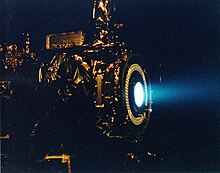Later Satellite Development

While Canada was the third country to build a satellite which was launched into space,[16] it was launched aboard an American rocket from an American spaceport. The same goes for Australia, whose launch of the first satellite involved a donated U.S. Redstone rocket and American support staff as well as a joint launch facility with the United Kingdom.[17] The first Italian satellite San Marco 1 was launched on 15 December 1964 on a U.S. Scout rocket from Wallops Island (Virginia, United States) with an Italian launch team trained by NASA.[18] In similar occasions, almost all further first national satellites were launched by foreign rockets.[citation needed]
After the late 2010s, and especially after the advent and operational fielding of large satellite internet constellations—where on-orbit active satellites more than doubled over a period of five years—the companies building the constellations began to propose regular planned deorbiting of the older satellites that reached the end of life, as a part of the regulatory process of obtaining a launch license.[citation needed] The largest artificial satellite ever is the International Space Station.[19]
By the early 2000s, and particularly after the advent of CubeSats and increased launches of microsats—frequently launched to the lower altitudes of low Earth orbit (LEO)—satellites began to more frequently be designed to get destroyed, or breakup and burnup entirely in the atmosphere.[20] For example, SpaceX Starlink satellites, the first large satellite internet constellation to exceed 1000 active satellites on orbit in 2020, are designed to be 100% demisable and burn up completely on their atmospheric reentry at the end of their life, or in the event of an early satellite failure.[21]
In different periods, many countries, such as Algeria, Argentina, Australia, Austria, Brazil, Canada, Chile, China, Denmark, Egypt, Finland, France, Germany, India, Iran, Israel, Italy, Japan, Kazakhstan, South Korea, Malaysia, Mexico, the Netherlands, Norway, Pakistan, Poland, Russia, Saudi Arabia, South Africa, Spain, Switzerland, Thailand, Turkey, Ukraine, the United Kingdom and the United States, had some satellites in orbit.[22]
Japan's space agency (JAXA) and NASA plan to send a wooden satellite prototype called LingoSat into orbit in the summer of 2024. They have been working on this project for few years and sent first wood samples to the space in 2021 to test the material's resilience to space conditions. [23]
Components
Orbit and altitude control
 Firing of Deep Space 1's ion thruster
Firing of Deep Space 1's ion thruster Most satellites use chemical or ion propulsion to adjust or maintain their orbit,[5]: 78 coupled with reaction wheels to control their three axis of rotation or attitude. Satellites close to Earth are affected the most by variations in the Earth's magnetic, gravitational field and the Sun's radiation pressure; satellites that are further away are affected more by other bodies' gravitational field by the Moon and the Sun. Satellites utilize ultra-white reflective coatings to prevent damage from UV radiation.[24] Without orbit and orientation control, satellites in orbit will not be able to communicate with ground stations on the Earth.[5]: 75–76
Chemical thrusters on satellites usually use monopropellant (one-part) or bipropellant (two-parts) that are hypergolic. Hypergolic means able to combust spontaneously when in contact with each other or to a catalyst. The most commonly used propellant mixtures on satellites are hydrazine-based monopropellants or monomethylhydrazine–dinitrogen tetroxide bipropellants. Ion thrusters on satellites usually are Hall-effect thrusters, which generate thrust by accelerating positive ions through a negatively-charged grid. Ion propulsion is more efficient propellant-wise than chemical propulsion but its thrust is very small (around 0.5 N or 0.1 lbf), and thus requires a longer burn time. The thrusters usually use xenon because it is inert, can be easily ionized, has a high atomic mass and storable as a high-pressure liquid.[5]: 78–79
Power
 The International Space Station's black solar panels on the left and white radiators on the right
The International Space Station's black solar panels on the left and white radiators on the right Most satellites use solar panels to generate power, and a few in deep space with limited sunlight use radioisotope thermoelectric generators. Slip rings attach solar panels to the satellite; the slip rings can rotate to be perpendicular with the sunlight and generate the most power. All satellites with a solar panel must also have batteries, because sunlight is blocked inside the launch vehicle and at night. The most common types of batteries for satellites are lithium-ion, and in the past nickel–hydrogen.[5]: 88–89
Communications
Applications
Earth observation
 Deployment of the Earth Radiation Budget Satellite on STS-41-G, collecting data on Earth's weather and climate
Deployment of the Earth Radiation Budget Satellite on STS-41-G, collecting data on Earth's weather and climate Earth observation satellites are designed to monitor and survey the Earth, called remote sensing. Most Earth observation satellites are placed in low Earth orbit for a high data resolution, though some are placed in a geostationary orbit for an uninterrupted coverage. Some satellites are placed in a Sun-synchronous orbit to have consistent lighting and obtain a total view of the Earth. Depending on the satellites' functions, they might have a normal camera, radar, lidar, photometer, or atmospheric instruments. Earth observation satellite's data is most used in archaeology, cartography, environmental monitoring, meteorology, and reconnaissance applications.[citation needed] As of 2021, there are over 950 Earth observation satellites, with the largest number of satellites operated with Planet Labs.[25]
Weather satellites monitor clouds, city lights, fires, effects of pollution, auroras, sand and dust storms, snow cover, ice mapping, boundaries of ocean currents, energy flows, etc. Environmental monitoring satellites can detect changes in the Earth's vegetation, atmospheric trace gas content, sea state, ocean color, and ice fields. By monitoring vegetation changes over time, droughts can be monitored by comparing the current vegetation state to its long term average.[26] Anthropogenic emissions can be monitored by evaluating data of tropospheric NO2 and SO2.[citation needed]
You received this message because you are subscribed to the Google Groups "1top-oldtattoo-1" group.
To unsubscribe from this group and stop receiving emails from it, send an email to 1top-oldtattoo-1+unsubscribe@googlegroups.com.
To view this discussion on the web visit https://groups.google.com/d/msgid/1top-oldtattoo-1/CAGNPKmmj29yBBHPp%3DE_F-_62_TV7JXmm6r3ettiPSz3CseNEBg%40mail.gmail.com.

No comments:
Post a Comment